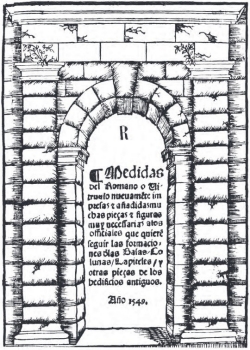During my four months at
The re-evaluation of Roman antiquity also coincided with a debate that arose in Italy in the writings of Pietro Bembo (1470–1547), in France (Guillaume Budé [1467–1540]), and in Spain (Antonio de Nebrija [1441–1522]) over the benefit of using Latin as a national language. Nebrija developed his first Castilian grammar precisely when the discovery of a new continent prompted the appropriation of Virgil’s Aeneid in retellings by Spanish humanists who sought to supplant Rome as a cultural referent, proposing Spain’s architectural past as a point of origin. Spanish literati identified in classical texts the names and locations of Roman settlements and described their remains, trying to demonstrate that Spain was as rich and unique as imperial Rome. In identifying the vestiges of Roman antiquity in Spain, these authors proposed them as paradigms, and they were used, for example, in the ephemeral architecture that Ferdinand of Aragon had constructed for his entry into Valencia upon his return from Naples in
It is important to clarify that one way of valuing architecture did not immediately replace another; rather, it was a centuries-long process.
In the second chapter, I detail the complex developments of the second half of the sixteenth century, when three lines intersected. In the first place, the rejection of paganizing architecture by the Council of Trent forced the decision of Philip II to adopt the architecture that, according to the Bible, God gave to man, understood in the mid-sixteenth century to be Solomon’s Temple, the form of which was a subject of debate. If Solomon achieved religious peace between Judah and the northern Israelite tribes, Philip II’s mission should be to achieve peace between the reformist Protestants and the Catholic church. As early as 1549, when, by order of Holy Roman Emperor Charles V, his son Prince Philip visited Brussels and later Ghent and other cities in the Low Countries, the ephemeral architecture that adorned the entrances repeatedly glorified a prince who wanted to be known as wise and prudent, following the example of King Solomon. For almost fifty years there was a debate about whether the architect Juan Bautista Villalpando’s understanding of the description of Solomon’s temple in the book of Ezekiel was accurate, and, as a consequence, whether the unornamented architecture he proposed for the Escorial was the correct interpretation sought by the monarch.
Parallel to this, in a Spain where Italophobia existed side by side with Italophilia, Philip, in his attempt to appear not as continuing in the line of the imperial Caesars but rather as the legitimate successor of the Visigoth monarchy, asked his chroniclers to locate in the north of Spain—where the Muslims had not penetrated—the remains of the earliest medieval architecture, in other words, a national architecture. The valorizing of the local soon gave way not just to the study of “Gothic” remains but also to exceptional works of Muslim antiquity, and to the publication of texts that praised the Alhambra of Granada and the Córdoba mosque.
In the face of these options, classicism, reclaimed for a time as a court style, gained new meaning after the publication in 1552 of Francisco Villalpando’s translation of books 3 and 4 of Sebastiano Serlio’s work on architecture, which detailed not an architectural grammar such as Sagredo’s but the forms of the architectural orders (as they were termed and described in book 4) based on ancient buildings (the subject of book 3). The publication of these two books provided a standard for those who wished to adhere to the principles of classical architecture.
Members' Research Report Archive
A History of the History of Spanish Architecture
Carlos Sambricio, Universidad Politécnica de Madrid
Ailsa Mellon Bruce Senior Fellow, spring 2013

Diego de Sagredo, Medidas del Romano (Toledo,
1549), frontispiece